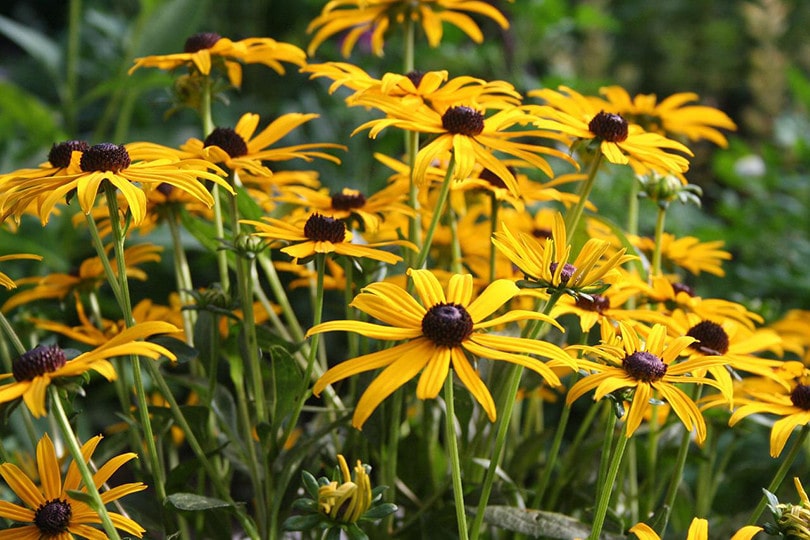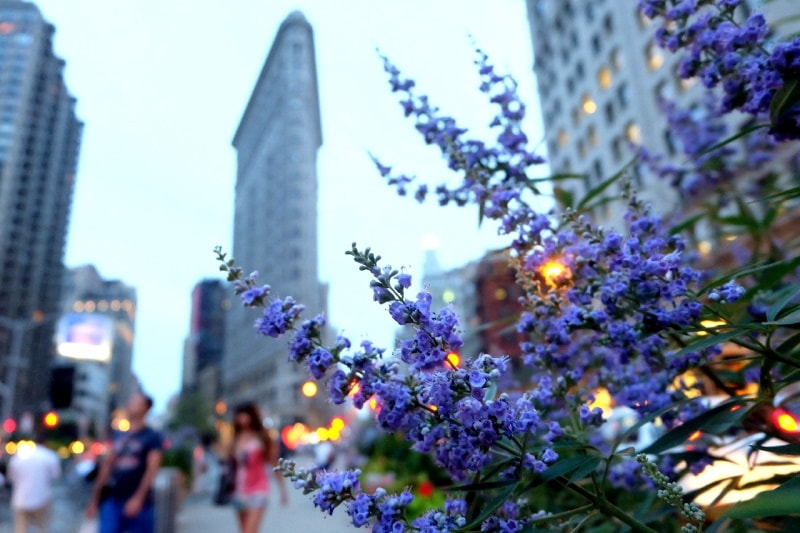10 Wildflowers That Grow In New Mexico (Identification Guide with Pictures)
-
Jana Blagojevic
- Last updated:

New Mexico is home to many remarkable species with unique characteristics that create a diverse and colorful spectacle. There are thousands of lovely plant species that are native to the US or that are proudly displayed in meadows and woodlands of the US. You are in the perfect place if you wish to learn more about the most popular wildflowers that grow in New Mexico.
Keep reading to see more exciting information that will make you a wildflower expert!
The 10 Wildflowers That Grow In New Mexico
1. Desert Honeysuckle

| Botanical name | Anisacanthus quadrifidus var. wrightii |
| Growing requirements | Full sun; well-drained soil, tolerant of any soil type |
| Hardiness | Zones 7 to 10 |
The Desert Honeysuckle is an erect deciduous plant with elegant upright stems decorated with small light-green leaves. They are bushy and can grow up to 5 feet tall. They can grow in any average soil and tolerate dry or moist environments. They thrive in full sun and require well-draining soil to survive. They look fantastic when planted in garden beds or containers, in rocky or cottage gardens. These plants are resistant to deer, free of pests, and attract many pollinators such as hummingbirds or butterflies.
The flowers of the Desert Honeysuckle bloom from early summer to fall, and they will appear in the gorgeous form of fiery-red tubular flowers. They are 2 inches long and resemble a honeysuckle, which is how the plant got its name.
2. Blanket Flower

| Botanical name | Gaillardia |
| Growing requirements | Full sun; loamy, well-drained soil, neutral or slightly acidic |
| Hardiness | Zones 3 to 9 |
Gaillardia, or the Blanket Flower, is a gorgeous short-lived plant that is incredibly easy to grow and thrive. The plant grows in the form of a mound, which spreads low on the ground surface, resembling a carpet or a thick blanket. They enjoy poor and well-drained soil, which is slightly acidic. They grow and spread fast; if you bought the plant from a nursery, it might be ready to bloom the same year.
The daisy-like flowers are colored in rich orange and dark red shades. The plant grows up to 24 inches tall and can spread like a mound 20 inches wide. The flower petals are bright yellow to whitish, while the center of the flower is large and dark.
3. Bull Thistle

| Botanical name | Cirsium vulgare |
| Growing requirements | Sunny areas; tolerant of any soil, whether moist or dry |
| Hardiness | Zones 3 to 8 |
Bull thistles can be seen throughout New Mexico, primarily in areas where vegetation and topsoil are lacking, such as roadsides and ditch banks. They are also quite common in sunny areas of pastures and woodlands, enjoying any soil. They grow several branched stems with leaves that are coarse on the top and gentle on the bottom. Leaves are long at the bottom, near the base, and become smaller as they grow closer to the top.
The flowers of the Bull Thistle can appear in small clusters or as solitary flowers. They are 2 inches wide and feature hundreds of tiny purple flower petals. The shape of the flower resembles a gumdrop, with tiny, needle-like hairs covering the bottom.
4. Bee Balm

| Botanical name | Monarda fistulosa |
| Growing requirements | Full sun exposure; evenly moist soil rich in organic matter |
| Hardiness | Zones 3 to 9 |
The Monarda or Bee Balm is a native American perennial which can often be seen in the woodlands of New Mexico. Bee Balm enjoys a lot of sun exposure and rich, evenly moist soil throughout the day. They tolerate shaded areas, especially during the hot summer months, when it’s better to plant them in a protected spot. They are excellent at attracting hummingbirds, bees, and butterflies and will make a wonderful addition to a pollinator garden.
The Bee Balm is easily recognizable by the attractive scarlet flowers, ranging from pink, purple, and lavender to dark red or white. The foliage is fragrant, another unique feature of this plant.
5. Black-eyed Susan

| Botanical name | Rudbeckia hirta |
| Growing requirements | Full sun exposure; moist soil, neutral or acidic |
| Hardiness | Zones 3 to 9 |
The Black-eyed Susan is a wildflower native only to the United States that is very easy to grow because of its self-seeding properties. It usually grows in natural areas and closes to roadsides, and they prefer neutral to acidic soil with well-draining properties. They adore sunny locations, although they are tolerant of a little shade. It is best to plant the black-eyed Susan after the last frost, at the very beginning of spring.
Black-eyed Susans have bright yellow petals with dark round centers. Their foliage has a rough texture, with green and hairy leaves.
6. Blue Vervain

| Botanical name | Verbena hastata |
| Growing requirements | Full sun or partial shade; average and evenly moist soil |
| Hardiness | Zones 3 to 9 |
One charming plant that deserves a spot on this list is the Blue Vervain. You can find this stunning herbaceous plant throughout New Mexico and all counties of Illinois. You can mostly find them in moist prairies and meadows near bodies of water such as ponds, marshes, and rivers. The flowers of the Blue Vervain attract most types of bees, including honeybees, bumblebees, and dagger bees, as well as wasps, butterflies, and various songbirds.\
The flowers of the Blue Vervain are slender and pencil-like, with tiny purple or blue tiny flower petals covering a certain portion of the flower.
7. Common Sunflower

| Botanical name | Helianthus annuus |
| Growing requirements | Direct sunlight exposure; dry and well-draining soil |
| Hardiness | Zones 2 to 11 |
The Common Sunflower is an elegant, branching annual plant which can grow as tall as 8 feet. The plant’s stem is tall and erect, slightly hairy, and with a coarse texture. It is usually branched and holds either one flower head or several flowers on one stem. It thrives in undisturbed areas like vast open fields and loves growing in dry soil. As you probably know, these plants adore basking in direct sunlight for multiple hours throughout the day.
This plant is one of the easiest ones to recognize when in nature. The flower heads are quite large, up to 5 inches in diameter, with a large dark center and sun-like flower petals spreading outwards.
8. Common Blue Violet

| Botanical name | Viola sororia |
| Growing requirements | Light or partial shade; medium moist, well-draining soil |
| Hardiness | Zones 3 to 10 |
The Common Blue Violet, Viola sororia, is a cute perennial plant native to eastern and central North America. This plant grows in the form of stemless, low, and bushy foliage with heart-shaped leaves. This plant can grow only from 6 to 10 inches tall and wide. It thrives in shady areas with access to natural lights and average, moist, well-drained soil. It can look amazing in garden beds, containers, borders, and as ground covers.
The flowers are large and very attractive. Their colors are usually blue or violet, with white throats. They bloom from mid-spring into late summer.
9. Common Periwinkle

| Botanical name | Vinca minor |
| Growing requirements | Partial sun or full shade; moist but well-draining soil |
| Hardiness | Zones 4 to 9 |
The Common Periwinkle is a very low-maintenance evergreen plant that grows as a perennial in warmer climates and as an annual plant in cooler regions. It has a unique creeping habit making it perfect when planted as ground cover. It can spread as wide as 18 inches and grow 6 inches tall. It is tolerant of soil, from loamy and sandy to clay soil. The periwinkle plant is toxic for animals when ingested and also slightly toxic for humans.
The flowers of Periwinkle are most commonly blue, although they can appear as lavender, white and purple. They are mostly seen on slopes and hillsides and appear as gentle five-petal clusters.
10. Dandelion

| Botanical name | Taraxacum officinale |
| Growing requirements | Full sun or partial shade; well-drained but fertile soil |
| Hardiness | Zones 3 to 9 |
Dandelions are incredibly beneficial wildflowers, even though they’ve been considered a weed by most gardeners. They have incredible uses in medicine in the form of teas, supplements, and natural remedies for many conditions. Their leaves can be used for a salad, and their roots can promote healthy digestion. While they are beneficial, they can also be a pleasant sight to watch, especially when it is in full bloom, when the wind disperses it.
Dandelions are one of the most famous wildflowers and can easily be recognized by their fluffy yellow flower heads. When in full bloom, the flowers will turn into soft seeds which the lightest wind can easily disperse.
Conclusion
Once you read about all the wildflowers you can find in New Mexico, you can go on and explore your surroundings in search of these unique species. You’ll be able to recognize some plants by their color, texture, or even fragrance.
Featured Image Credit: Piqsels
Contents
